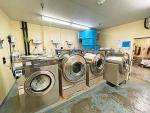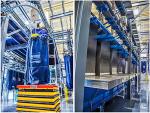CHICAGO — Laundry and linen services continue to learn from and deal with events that have taken place over the past few years.
That includes on-premises laundry (OPL) operations.
American Laundry News reached out to several professionals to find out what’s happening on the OPL side of the industry and communicated with three on-premises laundry representatives.
On the hotel OPL side, John Smith is the chief engineer of the Embassy Suites laundry in Indianapolis.
“It’s a 360-room property,” says Smith. “Every room’s a suite because it’s an Embassy, and we do all the laundry in-house. We don’t send anything out.”
On the healthcare side, Gustavo Guzman is laundry operation director for Community Memorial Healthcare in Ventura, California, a nonprofit, independent health system. Its on-premises laundry has been in operation for more than 55 years.
“We process an average of 2.6 million pounds annually,” shares Guzman. “Our product mix consists of core bed linens, scrubs for doctors and nurses, and EVS towels and mops.
“Our washroom consists of three Milnor 450-pound washers, two CLM 400-pound steam dryers, and two Chicago roll ironer, feeder and folders. We process six days per week and use an exchange cart program to service the CMH system.”
Finally, Eric Meyers brings a consultant’s view to the state of OPL operations. He owns laundromats and is the general manager for the North America trade/OPL segment for Alliance Laundry Systems.
EFFECTS OF THE PAST FEW YEARS
Smith says that his OPL was affected by the supply-chain challenges over the past few years.
“We were getting to the point that we were washing the same sheets that we had on the bed today trying to get them back on the bed for check-in later,” he shares.
“We were getting no shelf life out of the linen at all. It was just really hard to get linen for a while. We never ran into a problem of running out product. We use Ecolab for our soap and never had a problem getting any of the product for that.
“We had to go out and find new sources to get linen. A lot of that has eased, and we now have plenty of par. We run a three-par here at the hotel.”
Smith says that when travel started up again after the pandemic, getting staff was the major challenge.
“We did what we had to do to get staffing,” he says. “We brought back people that had been laid off and some of them didn’t want to work. They were making more to sit at home. With those programs ending, we were able to settle our deficit in employees by bringing them back.”
Then Smith says the hotel’s equipment was failing, and they started replacing it.
“That’s how I hooked up with Yamamoto North America, and he supplied me with the washer we got put in,” he says. “We liked it so well that we’ve replaced all of our washers with that.”
Meyers notes the same issues when he looks at hotel OPLs across the country.
“The pandemic certainly had a negative impact primarily due to the fact that the occupancy rates fell off a cliff when everything was shut down,” he says. “And then, when they started to allow travel to happen, then we ran into, all of the sudden, labor problems.
“The hospitality community in particular has started developing huge labor problems, which, coupled with the lack of occupancy, caused the hotel operators and owners to change their ways.”
Meyers says hotels used to turn their rooms, providing clean sheets and towels, every day. Today, there are notices posted in the rooms that guests must let the hotel know that they want their bed turned over or want more linens or want the room cleaned.
“They really have no intention of doing that during your stay unless you specifically request it, and because of that, it significantly reduces the need for laundering of all the hotel linens and towels, etc.,” he points out.
“That reduces the amount of usage on the laundry equipment. The number of turns per day reduces, which means it reduces the amount of wear and tear, which reduces when it breaks, which reduces when it hits end of life, which means they buy less equipment.”
However, Meyers has seen a significant bounce back in hotel OPL sales because travel has increased greatly across the country.
“That’s surprising to me that it bounced back more than I thought it would, but I think the American people, just when it came time where they were allowed to have a normal life again, they did it with gusto,” he says.
On the healthcare side, Guzman says the pandemic affected his laundry operation, but it was able to properly serve its patients with the core linens.
“Supply-chain issues did affect our daily operations, but once we built up our inventory levels, we were able to cope with patient linen requests,” he shares. “We introduced the yellow isolation gown that overnight became the most requested item for all departments.
“Our textile vendor, Standard Textile, came through with the needed inventory throughout the pandemic with minimal disruption to our supply chain. Overall inflated cost did not hamper our laundry operation as vendors held back any major increases.”
Labor staffing shortages have been a constant battle, Guzman shares, along with the ability to expand the laundry facility due to a lack of available space to grow the footprint of the laundry.
“Steps taken to overcome the labor shortages involved extending the staffing hours adding an optional sixth day for those team members that choose to sign up,” he says. “Overall, our laundry staff kept stepping up to help with any linen deliveries, which helped to maintain a high patient linen fill rate.
“Unlike hospitals that do not have their own OPLs, we were able to expedite increases in linen demands, in most cases on the same day.”
Check back Tuesday for the conclusion with a status report on OPL operations today and what may come.
Have a question or comment? E-mail our editor Matt Poe at [email protected].






















































































































































































































































